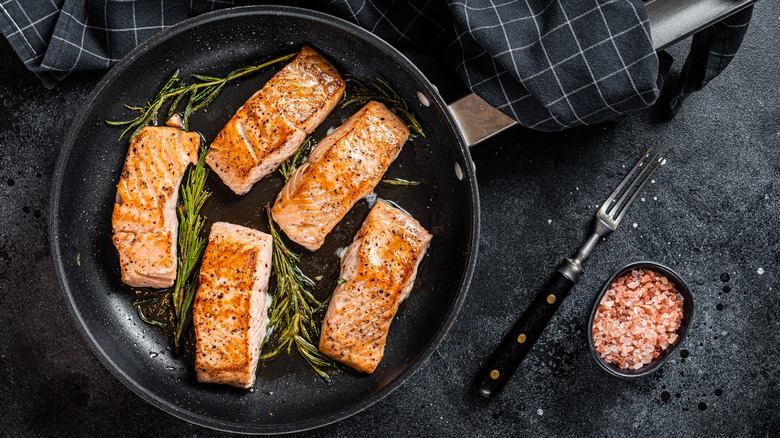Add More Fat To Avoid Ruining Your Salmon
There are few dinners quite as good as a perfectly-cooked salmon fillet. But how do you get the best texture and the perfect internal temperature, with none of that dreaded sticking that mangles the fish? A little extra fat. Underestimating the amount of additional fat required to properly cook this fish is one of the most common mistakes that everyone makes when cooking salmon. Whether it's oil, butter, or even an animal fat like lard, a generous amount prevents the salmon from sticking to the pan while also providing an extra source of flavor.
While salmon is a naturally fatty fish, the oil rendered from its skin and flesh are insufficient on their own and need a little extra help. Salmon also does not absorb much extra fat when cooking, so you can add oil or butter to it without worrying about compromising its natural flavor or fat content. What kind of fat you use and how you apply it depends entirely on your recipe and cookware. Whereas a hot and fast pan sear requires a neutral oil, a slow bake can use anything from mayonnaise to butter. Understanding the different types of fat, how to best apply them, and what temperatures they work best at is vital to nailing your recipe.
What kind of fat to use for salmon and how to apply it
When you cook up some crispy salmon steaks or seared salmon with sautéed pea shoots, it's best to use oils that stand up to heat well. After all, salmon sears quickly, so you need that high temp to get a nice golden crust on the outside while the inside rapidly approaches your desired temperature. Brushing a thin layer of vegetable or sunflower oil over each side of the fish ensures even coverage, and minimizes excess oil in the pan, which might start to burn and add a bitter flavor.
Olive oil can work on the grill if you cook the fish for a shorter time (like in this grilled salmon salad recipe). The radiant heat won't burn the oil as harshly as direct contact of a hot pan, and brushing the salmon with oil keeps it from sticking to the grates. Keep in mind that olive oil has a smoke point between 350 and 470 degrees Fahrenheit, depending on its classification. If you're looking for a hot, fast grilling method, don't use extra virgin olive oil, which burns more easily.
In the gentler heat of the oven, the fat you can use becomes even more flexible. Even butter, which has a lower smoke point of 300 degrees Fahrenheit, fares well with baked or roasted salmon wrapped in foil. Mayo is another option — this simple Dijon-crusted salmon uses the rich condiment to protect the fish from drying out, and to help a crunchy breadcrumb topping stick to it.


